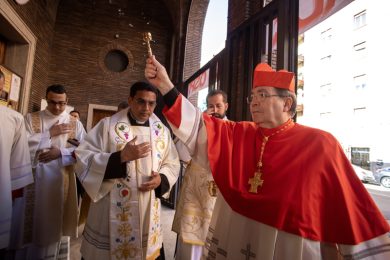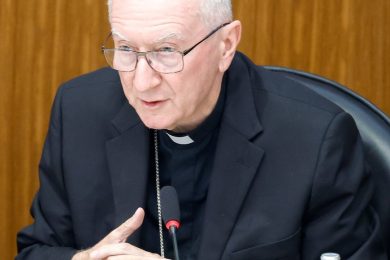St. Cloud Bishop Donald Kettler and Minnesota’s other bishops will travel to Rome from Jan. 11 to 18 for their “ad limina” visit.
“Ad limina” comes from the Latin phrase “ad limina apostolorum” (“to the threshold of the apostles”), a reference to the pilgrimage to the tombs of Sts. Peter and Paul that bishops are required to periodically make. The latest round of “ad limina” visits for U.S. bishops began last November and will continue through February.
To prepare, each bishop compiles a detailed report of the life of the Catholic Church in his diocese, and during the trip he will meet with various offices of the Roman Curia. But, at their core, “ad limina” visits are more than a series of business meetings.
As the “Directory for the ‘Ad Limina’ Visit” makes clear, the visits are a pilgrimage with “a very definite purpose: that is, the strengthening of their own responsibility as successors of the Apostles and of their hierarchical communion with the Successor of Peter. The point of reference is a visit to the tombs of Sts. Peter and Paul, pastors and pillars of the Roman church.”
And, in fact, at the heart of the bishops’ pilgrimage are Masses at the Rome basilicas of St. Peter, St. Paul Outside the Walls, St. John Lateran and St. Mary Major. They also will meet with Pope Francis.

“It’s a graced time to meet with the pope — that’s one of the big things,” said Bishop Kettler, who will be accompanied on the trip by Father Robert Rolfes, vicar general, and Father Timothy Baltes, chair of the diocesan priest personnel board and pastor of St. Francis Xavier Parish in Sartell.
“Then, it’s like we’re on a missionary journey, as the apostles were, by visiting the four churches,” said Bishop Kettler, whose last “ad limina” visit was in 2012 when he headed the Diocese of Fairbanks, Alaska, during the pontificate of Benedict XVI.
Over the past 35 years, the meetings with the pope have changed significantly because of the increased number of bishops in the world.
Canon law calls for the visits to occur every five years. But that hasn’t happened since early in the pontificate of St. John Paul II. According to the latest statistics released by the Vatican, there are now 3,017 dioceses, prelatures and vicariates around the world. When St. John Paul II was elected in 1978 there were 2,423.
St. John Paul would meet privately with each and every head of a diocese during the “ad limina” visits; he would invite groups of them to his morning Mass; and he would give a speech to each group.
Midway through his pontificate, Pope Benedict XVI adopted a modified format, meeting with seven-10 bishops at a time instead of having individual encounters. He also cut down on the number of speeches he gave — for example, giving formal addresses to only five of the 15 groups of U.S. bishops in 2011-12.
The format changes have continued under Pope Francis. His regular practice now is to meet each group together — with sometimes 20 bishops sitting in a circle in the papal library — devoting between 90 minutes and two hours to a free-wheeling discussion.
According to bishops who have made their “ad limina” visits in the last year, Pope Francis tells the bishops they are free to comment about or ask him anything. Then, using a soccer metaphor, he tells them the ball is in play and whoever wants to kick things off can.
Also making their “ad limina” visits at the same time as the Minnesota bishops will be the bishops from North Dakota and South Dakota as well as the bishops from Iowa, Kansas, Missouri and Nebraska.
CATHOLIC NEWS SERVICE AND STAFF REPORTS





















